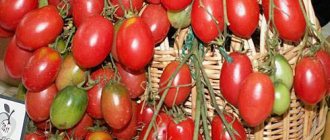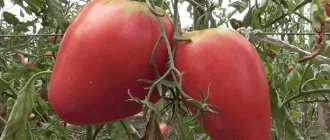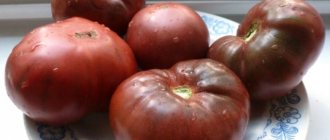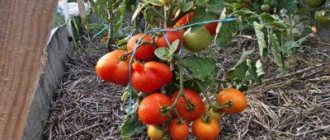Cherry tomatoes are a variety of tomatoes that have become increasingly popular lately. They can be of different types - standard or indeterminate, complex or simple (if we are talking about the structure of brushes), different colors and completely different shapes. At the same time, the taste of cherry tomatoes has a very sweet taste, which sometimes gives off fruity notes. They can be used to decorate various dishes; cherry tomatoes can be added to salads or other dishes. You can also dry them, since they contain a large amount of dry things. Cherry tomatoes also look great inside marinades. But most of all, cherry tomatoes are liked by small children, who can eat these small tomatoes fresh from the bushes. In this article we will take a closer look at an unusual variety, and its name is the Pinocchio tomato, which today is gaining more and more popularity among many gardeners.
General information about the variety
The cultivar was included in the list of domestic breeding achievements (State Register) in 1997. The originator of the indoor tomato is Aleksasheva Marina Vitalievna.
Pinocchio is a medium-ripening tomato. From germination to harvest, an average of 100-115 days pass.
Characteristics of the bush
Pinocchio is a low-growing standard-type tomato. This means that the plant does not require garters or pinching, which greatly facilitates caring for the crop at home and in the open ground.
The height of the bush does not exceed 20-35 cm. The leaves of the cultivar belong to the intermediate type, are medium-dissected, and have a dark green color.
Description and taste of fruits
Pinocchio produces small flat-round cherry fruits, the weight of which does not exceed 20 g.
At the stage of technical ripeness, tomatoes are light green with a dark spot in the stalk area. Fully ripened fruits acquire a deep red color. There are 2 or 3 chambers inside a tomato.
The taste qualities of the variety were determined by the state variety commission to be excellent and good. This is confirmed by the reviews of vegetable growers left about the Pinocchio variety.
Productivity and Application
The yield of Pinocchio tomato declared by the manufacturer is 1-1.5 kg per plant. Such results can be achieved only with the correct agricultural technology for indoor tomatoes.
The fruits are intended for fresh consumption, preparing salads and for pickling for the winter.
Harvesting and application
Pinocchio tomatoes ripen in early July. All the fruits on the bushes will ripen almost simultaneously.
The fruits are arranged on clusters of 8-10 pieces. You need to pick off the whole brush at once.
Tomatoes are best stored on the trusses. They are placed in the refrigerator in individual plastic containers.
Pinocchio tomatoes are suitable for fresh consumption and canning. Due to their concentrated flavor, they are often used for drying. Therefore, from a gastronomic point of view, the variety is considered universal.
Planting dates and sowing
At home, Pinocchio tomatoes can be grown all year round if you create a favorable environment for the development of the crop: high-quality lighting, suitable temperature, regular fertilizing.
If the tomato will grow on a balcony, in a greenhouse or open ground, the manufacturer’s recommended sowing time is the third ten days of March (from the 20th to the 30th of the month).
Selection of landing containers
If you plan to cultivate the Pinocchio tomato variety in the future in open ground, common seedling boxes are suitable for sowing. At the stage of formation of 2-3 leaves, seedlings are planted in separate cups.
When growing at home, it is recommended to choose specialized pallets, of which there is now no shortage in gardening stores.
You can also take 200 ml plastic transparent cups. 2-3 seeds are planted in them at once. After germination, one or two weaker seedlings will have to be separated by cutting them off at the root with nail scissors.
Preparing seeds and soil
It is recommended to use specialized soil for homemade tomatoes - for tomato seedlings. It allows air and water to pass through well and contains all the necessary elements that plants will need at the first stage of development.
It is recommended to pre-disinfect purchased soil. This will avoid problems at the stage of growing seedlings, such as blackleg.
The soil can be frozen on the balcony 2 weeks before planting, calcined in the oven, and poured with boiling water.
If none of the options are suitable, the substrate should be shed with at least a solution of Fitosporin. The drug suppresses pathogenic fungal flora of the soil mixture and populates it with beneficial microorganisms.
Pinocchio seeds are also pickled in a Fitosporin solution for 1-2 hours. Afterwards, the planting material is dried and planted in the prepared soil.
Planting seeds
When planting in a common container, the distance between the seeds in the furrow should be at least 1 cm and 2 cm in the row spacing.
The Pinocchio variety has small seeds, unlike the usual medium and large-sized tomatoes. Therefore, it is not recommended to lay planting material to great depths. Otherwise, the seedling will not have enough strength to reach the surface. The recommended embedment depth is no more than 0.5 cm.
The planted seeds are sprinkled with a substrate, the surface of the ground is moistened with a spray bottle, and covered with film or glass to create a greenhouse effect. Place in a warm place. In an apartment, this may be the area under the heating radiators.
The crops are ventilated 2-3 times daily, leaving the planting containers open for half an hour.
Check the soil moisture regularly. It should not dry out, but it should not be allowed to soak either. Wet the soil moderately as it dries.
As soon as the first seedlings begin to hatch, the shelter is removed and the seedling boxes are placed closer to the light source.
How to grow a Pinocchio tomato
Before you begin the main preparatory work, you need to purchase seeds. There are no particular problems in solving this issue, since the Pinocchio tomato is a frequent guest in the shopping pavilions of the “Garden/Vegetable Garden” category and on online store websites.
After purchasing seeds, it is necessary to carry out their pre-sowing treatment, since they often go on sale untreated (not dyed or treated). A pale solution of potassium permanganate, in which the seeds are kept for no more than 15 minutes, will help solve this issue. When the seeds dry, they will be ready for further use.
Planting seedlings
Before you start planting, you need to prepare the soil. You can purchase a specialized peat-containing mixture for planting tomatoes. If there is no trust in purchased mixtures, then the soil in which the seeds will be planted should be prepared in advance.
To prepare the earth mixture you need:
- in the fall, stock up on a certain amount of soil (it is better to dig under an acacia tree);
- carry out heat treatment of the soil in the oven for at least 4 hours;
- treat the soil with a solution of potassium permanganate by watering.
After treating with a fungicide, the soil must dry out, and only then can further preparation be continued. Additionally, you will need humus and peat, which are added to the treated earth mixture in equal proportions - 1:1:1. By thoroughly mixing all the components, you can obtain a light substrate for planting seeds.
The seeds and soil are ready, now it’s time to start preparing containers for growing seedlings.
Absolutely any containers can be used:
- plastic cassettes;
- disposable tableware (new and used);
- peat cassettes, glasses and tablets;
- pots (new and used).
Important! Before using used containers, they must be disinfected with a solution of any fungicide.
There is no need to deeply deepen the seed - the maximum planting depth is 1 cm, after which the planted seeds are watered with water at room temperature, covered with cellophane and placed in a warm place. After the first shoots appear, the covering material must be removed and, after waiting for 2-3 true leaves to appear, you can begin picking the seedlings.
Before starting the diving procedure, it is necessary to add organomineral fertilizers in the form of dry powder or water-soluble granules to the soil. The required amount of fertilizer is mixed with the soil, after which the seedlings can be planted.
Tomato transplant
No later than 2 months after sowing Pinocchio tomato seeds for seedlings, the procedure of transferring the seedlings into containers should be carried out. This procedure is more applicable for subsequent cultivation of tomatoes on a balcony or windowsill. Seedlings of this tomato variety have a poorly developed root system, and therefore during transplantation the likelihood of injury to the roots is very high.
Important! Transshipment is the procedure of replanting a plant along with a lump of earth in which they grew, without damaging the root system.
If the Pinocchio tomato variety is planned to be grown outdoors, then replanting should be carried out in the second ten days of May, when there is no threat of night spring frosts. To obtain a larger harvest of cherry seedlings, seedlings should be planted according to a more compacted pattern - per 1 square meter. m accommodate up to 10 sprouts. The root system of this variety is small, and this form of planting will not interfere with the development of each bush individually.
Important! We must not forget about the hardening procedure of tomato seedlings before planting them in a permanent place of cultivation in open ground.
Subsequent care for tomatoes
Like all standard forms of plants, Pinocchio cherry tomatoes are not capricious in care: they do not produce stepsons and do not need a garter. But the number of fruits that form over time can, with its weight, break the trunk of a miniature bush, so it must be provided with support. Photos of Pinocchio tomatoes clearly demonstrate the importance of using support.
Plants need fertilizers with a minimum nitrogen content and a high content of phosphorus and potassium (N:P:K - 4:5:6). Phosphorus promotes better development of the root system, and potassium promotes rapid ripening of cherry tomatoes. Nitrogen in excess amounts can be a disservice, because this variety has absolutely no need for green mass growth.
The Pinocchio tomato variety is not particularly demanding when it comes to watering, and it should only be done in the morning or evening with water that has been settled and heated in the sun, strictly at the root level. Unlike bushes that grow indoors, outdoor plants can react negatively to moisture entering the green mass of plants. Indoor tomatoes, on the contrary, need moisture very much, since the air indoors has low humidity.
Growing seedlings
When planting seeds in March and keeping the seedlings on a south or south-east windowsill, Pinocchio seedlings will have enough light. When sowing earlier or growing tomatoes on the non-sunny side, additional lighting will be required. Tomatoes need additional lighting for 12 hours a day.
After the formation of 2-3 true leaves, Pinocchio seedlings are planted in separate 200 ml cups. The procedure is necessary if tomatoes will be grown in open ground.
If the tomatoes were planted on pallets, the transplanting process can be delayed for several weeks. In the latter case, the procedure is carried out using the transshipment method.
When grown in separate cups, seedlings are sprinkled with soil along the cotyledons.
After picking, the seedlings are fed 2 weeks later with a special complex for tomato seedlings (Agricola, Orton-seedling, Zdraven, etc.).
When grown in separate containers and pallets, fertilizer is given for the first time after the formation of 3-4 leaves on the seedlings.
Every 10 days, Pinocchio seedlings are treated with Epin, which can be alternated with Zircon.
After 2 months, the tomatoes are transplanted into separate 3-5 liter pots or planted in open ground.
Growing tomatoes in pots on a windowsill
The tomato is transferred into a large pot, trying to carefully remove it from the old container without damaging the earthen lump. Sprinkle with soil and water abundantly.
According to reviews and photos on the Internet, the Pinocchio tomato is successfully grown on the balcony in ordinary plastic 5-liter bottles.
Next, the bushes need the following care:
- watering as the substrate dries;
- loosening the soil in the pot 1-2 times a week;
- root feeding once every 3 weeks;
- treatment of half a leaf with Epin once every 10-14 days.
After the second flower cluster is extended, Pinocchio is given fertilizer with a high content of potassium and phosphorus, necessary for the formation of fruits. The drug can be used as a fertilizer at this stage. During the flowering period, tomatoes also respond well to boric acid.
When growing Pinocchio on a windowsill, preventive treatments against diseases and pests are usually not necessary. The exception is when there are sick indoor plants at home that are infested with pests.
When kept on the balcony and in hanging pots near the house, preventive treatment with Fitosporin against fungal diseases is desirable.
The fruiting period for Pinocchio when grown at home begins in late July and early August.
Features of care
The plant requires heat and at night the temperature should not drop below +18 C, otherwise the yield of tomatoes will decrease. Care mainly consists of moderate watering and fertilizing the soil.
The first fertilizing with complex fertilizers is carried out after the appearance of the fifth leaf. The second enrichment of the soil with nutrients is carried out no earlier than after 10 days. Regular harvesting of ripe tomatoes will help increase fruiting rates.
Cultivation in open ground
In the southern regions, you can move Pinocchio tomato seedlings to the beds in mid-May. For the Northern strip, suitable planting dates are the end of May or the beginning of June.
In open ground, they adhere to the arrangement between the bushes - 50 by 30 cm.
Planting process:
- The seedling is carefully removed from the cup, trying not to damage the earthen lump.
- Place the plant in the center of the prepared hole so that the lower leaves are located just above the edge of the hole.
- Sprinkle with earth and press it around the bush.
- Water generously.
The procedure is carried out on a cloudy morning or evening.
Agricultural technology for cultivating in beds is standard:
- Watering as needed;
- Loosening the soil once a week.
- Feeding 3 times per season.
When cultivated in open ground, Pinocchio does not need as frequent feeding as when kept in pots on a windowsill or balcony. There the plant is kept in a confined space and quickly consumes the nutrients that it needs to be supplied through regular feeding.
When grown in beds for the first time, the crop is fed after transplantation after 2 weeks. Then Pinocchio is fertilized in the flowering phase, adhering to the same rules in feeding the tomato as when maintaining a house. Use specialized fertilizers marked “Ovary” or boric acid. Pinocchio also responds well to feeding with superphosphate.
In open ground, it is imperative to prevent fungal diseases by spraying the bushes with Fitosporin.
The first harvest begins to form in early to mid-August.
Reviews from gardeners
Gennady, Anapa
Where grown: open ground.
“I love cherry tomatoes, they seem neat to me. I purchased the Pinocchio variety last year, just for testing. And I didn’t regret it. Not only was the yield quite good, but I also didn’t get sick! And for some reason the insects avoided him, probably thinking that he was still very small!))). I collected seeds for next year, so I will plant more!”
Love, Irkutsk
Where I grew it: windowsill.
“What I like about the Pinocchio variety is that it can be grown all year round! Sometimes you really want to try fresh tomatoes, but somehow you don’t want to go to the store for bland, tasteless and expensive tomatoes. That's why I planted him. When I harvested my first harvest, I immediately posted a photo to show off! Now I even treat guests, and dry it, and salt it. And I recommended it to all my friends!”
Armen, Vorkuta
Where grown: windowsill.
“I’ll be honest: I’m a lazy summer resident. I don’t like to mess around in the garden all the time, constantly spraying the bushes with poison from all kinds of insects, fighting weeds or loosening the soil. Therefore, Pinocchio is just a salvation for me: small, convenient, does not take up much space. If you want tomatoes all year round (unless, of course, you are going to grow them industrially), take this variety.”
Similar varieties
According to the characteristics and description of the variety, many tomatoes intended for windowsills and balconies are similar to Pinocchio:
- Balcony Miracle is a dwarf cultivar of ultra-early ripening. Just like Pinocchio, it can be grown in any conditions - on a window, balcony, unprotected beds. Suitable for cultivation in open ground without seedlings. Tomatoes are larger than Pinocchio's and can weigh up to 40 g when grown in garden beds. In this case, the height of the bush is usually no more than 30 cm.
- Bonsai is one of the best balcony varieties with an ultra-early ripening period. The dwarf bush does not exceed 20-30 cm in height at home. The manufacturer assures that pots with a volume of no more than 2 liters are suitable for growing the crop at home. During the fruiting period, the bushes are covered with cherry tomatoes weighing up to 25 g.
- Indoor surprise - a super early tomato that produces plum-shaped fruits weighing up to 60 g. The height of the bush does not exceed 50 cm.
- Baby - produces the first harvest 85-90 days after germination. It bears fruit abundantly, forming cherry tomatoes weighing 12-15 g on miniature, compact bushes. It is highly decorative.
Advantages and disadvantages
Plants are disease resistant
The advantages of this variety include:
- compact appearance and universal use;
- resistance to cracking and major diseases;
- friendly early fruiting;
- ease of cultivation.
This variety also has disadvantages. They consist in low yield and fragility if grown indoors.











